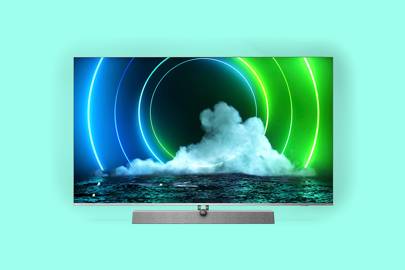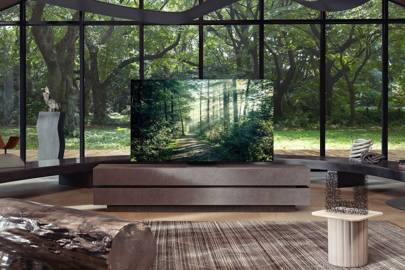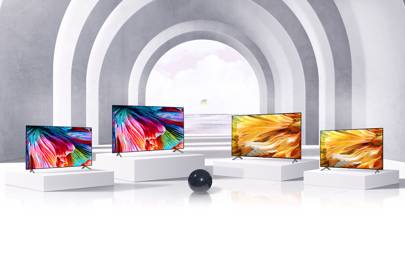
If you’re in the market for a new flatscreen, listen up. There’s about to be a seismic shift in the TV landscape, a telly-quake that will quite literally change the way you watch the box.
Driven by the next-gen gaming market, a combination of revolutionary new display technologies and advanced functions are conspiring to make 2021 the most exciting year for TV launches since the first sighting of 4K back in 2012. Let’s unpick the immediate future of television.
Mini LED – it’s big news
The biggest TV development in 2021 is the arrival of Mini LED, a triple-threat display innovation that promises a quantum leap in HDR performance, particularly for upper mid-range models, HFR (High Frame Rate) support for next-gen gamers and freedom from image retention, or burn-in. Three manufacturers are leading the charge.
Samsung will sell Mini LED sets under a new ‘Neo QLED’ moniker, LG has christened its incoming models ‘QNED’, and Philips is calling its offerings (rather unimaginatively but winning points for clarity) ‘Mini LED’.
Simply put, Mini LED is a new backlight technology for LCD TVs. Mini LED screens trade the traditional LED LCD backlight, be it a full array or edge lighting, for an entirely new light source that offers far better dimming control and HDR handling.
Imagine thousands of microscopic LED lights, all under precise control, in a display that’s both wonderfully thin and able to give OLED pictures a run for their money.
Mini LED will feature on Samsung’s flagship 8K QN900A model, but may also appear on the 8K QN800A (details are a bit vague at the moment). The brand’s 4K TV range-topper, the QN90A, will also use a Mini LED light source.
While Samsung is positioning its Mini LED models at the top of the TV tree, rival LG is placing at least some screens into the more competitive midrange. Christened QNED, they’ll sit just above stablemate Nanocell LED TVs, which use a conventional backlight.
LG’s first QNED Mini LED TV models, the QNED99 and QNED95, claim a contrast ratio of 1,000,000:1, with 2,500 dimming zones.
Philips will follow with two TVs using Mini LED technology later in the year. The 9636 and 9506 Series will ship in 65- and 75-inch screen sizes.
Remember, crucially Mini LED doesn’t just raise the bar when it comes to LCD TV imagery, it also has another trump card that OLED struggles to match. It’s free from burn-in, and that’s a big deal for gamers who often have to contend with plenty of static imagery on-screen. With OLED, burn-in anxiety remains all too real.
OLED – higher luminosity screens are coming

Not that OLED is taking a backseat in 2021. The boffins at LG Display continue to push the technology harder than ever, and the result is OLED Evo, above, a high luminosity OLED panel offering the biggest upgrade in peak brightness in years. OLED Evo technology will debut on the brand’s G1 series, so it won’t be cheap – but it’ll almost certainly be gorgeous.
It’ll be interesting to compare OLED Evo to Panasonic’s custom modified Master HDR OLED Professional Edition panel, also not cheap, first seen on 2020’s HZ2000 and returning this year on the very similar looking JZ2000. Customised by Panasonic R&D engineers for higher peak and average brightness levels, Panasonic has set a high bar for OLED image quality, so we could be in for quite a scrap as the brands battle for the PQ high ground.
TV in 2021 is all about gaming, not home cinema
There’s a good reason we’re seeing a flurry of activity on the TV front this year. For the first time, gaming and not home cinema, is driving the feature agenda. Enter HFR (High Frame Rate) – the killer app for 2021 screens.
If you aspire to be a next-gen joystick jockey, the best reason to upgrade your TV in 2021 will be to get HDMI v2.1 functionality, specifically 4K 120fps HFR support. High frame rate compatibility was rarer than hen’s teeth on 2020 TVs, but it’s looking almost ubiquitous on this year’s mainstream models.
Also touted as an 8K input, this high bandwidth HDMI input lets you run the PlayStation 5 and Xbox Series X at their highest frame rate, for silky smooth graphics. Admittedly, not many titles support 4K 120fps, but it’s early days and the catalogue will grow.
And 2021 screens aren’t just about HFR inputs; they’ll herald new gaming modes, too. LG’s 2021 fleet have a new ‘Game Optimizer’ mode, which promises a low input lag of just 1 millisecond, automatically applying the most appropriate picture settings according to the type of the genre being played.
The Panasonic JZ2000 OLED has ‘Game Mode Extreme’, which it says reduces image lag down to around 14ms.
But it’s Samsung which has the most remarkable gaming feature. ‘Ultra Wide Gaming’ mode means compatible screens will be able to display an extreme 21:9 (or even 32:9) widescreen image, with an input lag of less than 10ms. Even better, this ultra-letterbox display mode can be manually shifted up or down to match your eye level. It’s like having the most widescreen gaming monitor ever made, on a regular TV.
The sets to watch for in 2021
Given this tasty new tech, hopefully you can see why there is legitimate reason to be more excited than ever for this year’s screens. So which sets should you keep an eye out for? Here’s our early shortlist.
Samsung 65-inch QN90A Mini LED Neo QLED

Samsung’s 4K flagship is looking formidable. With its Mini LED light source, a screen just 25mm deep and Ultra Wide gaming with 4K at 120fps, this could be the screen to beat in 2021.
LG 65-inch QNED95 Mini LED TV

LG looks set to undercut its rivals when it comes to Mini LED technology. So if you’re after a 4K 120fps TV with OLED-like performance, this could be the hot ticket. It’ll also feature a dramatically reimagined webOS smart platform, too.
Sony 65-inch X95J Full Array LED TV
Sony didn’t really have much of a TV range in 2020 able to take advantage of the PlayStation 5, but that all changes in 2021, and its top-end BRAVIA Full Array LED panel TVs seem well worth watching out for. There’s no Mini LED here, but the sets do feature a new Cognitive Processor XR, for naturalistic image enhancement of 4K and HD sources, plus an all new ‘XR Motion Clarity’ mode. And, yes, that new processor means that 4K 120fps inputs are locked and loaded.
Philips 75-inch 9636 Mini LED TV
Philips is loading its Mini LED flagship, top image, with a tantalising array of goodies. In addition to four-sided Ambilight mood lighting, it’ll have a 3.1.2 Bowers & Wilkins Dolby Atmos sound system with Tweeter-on-Top technology, and image handling managed by the brand’s 5th generation P5 AI picture engine, with ‘enhanced AI’ and advanced Motion Clarity.
Prices on all the above have yet to be announced.
More great stories from WIRED
☀️ Coronavirus experts explain what summer 2021 will be like
🎧 Looking for new headphones? Here’s how to buy the best, whatever your budget
🐶 Fraudsters and thieves are cashing in on the pandemic puppy boom
🔊 Listen to The WIRED Podcast, the week in science, technology and culture, delivered every Friday
👉 Follow WIRED on Twitter, Instagram, Facebook and LinkedIn





